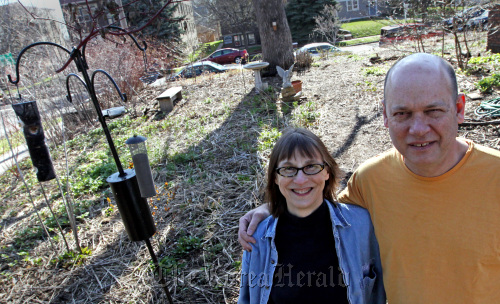MINNEAPOLIS -- About a dozen years ago, Paul and Susan Damon of St. Paul, Minnesota, did something radical: They deliberately killed half their lawn.
A few years later, they killed the rest of it.
Gradually, they‘ve transformed their city lot into a small urban prairie, with more than 130 species of native plants. “We wanted to turn it into a haven for birds and butterflies,” said Paul, a landscape architect. And they succeeded; their garden now attracts 75 to 80 species of birds and sometimes “clouds” of butterflies. “When we planted natives, all of a sudden, everything came to life,” Susan said.
Across the river in Minneapolis, Wayne Beauchemin and Jamie Becker also have eliminated all lawn from their landscape.
They started in front, with a boulevard garden and shaded woodland garden. Two years ago, they replaced their back-yard lawn with a French-style cottage garden, inspired by their travels. “We decided, ‘Why don’t we do that here and pretend we’re in France?’” Beauchemin said.
A few years later, they killed the rest of it.
Gradually, they‘ve transformed their city lot into a small urban prairie, with more than 130 species of native plants. “We wanted to turn it into a haven for birds and butterflies,” said Paul, a landscape architect. And they succeeded; their garden now attracts 75 to 80 species of birds and sometimes “clouds” of butterflies. “When we planted natives, all of a sudden, everything came to life,” Susan said.
Across the river in Minneapolis, Wayne Beauchemin and Jamie Becker also have eliminated all lawn from their landscape.
They started in front, with a boulevard garden and shaded woodland garden. Two years ago, they replaced their back-yard lawn with a French-style cottage garden, inspired by their travels. “We decided, ‘Why don’t we do that here and pretend we’re in France?’” Beauchemin said.

An expanse of manicured turf grass has been the default American landscape for many decades, but that’s starting to shift.
And while eliminating the lawn completely is an unusual step, more and more homeowners are interested in having less lawn and more garden or other lawn alternatives. Reduced lawn was recently identified as a top trend by the American Society of Landscape Architects.
“It‘s really changed,” said Evelyn Hadden of Plymouth, Minn., an author and early less-grass advocate. When she founded Less Lawn (www.lesslawn.com) in 2001, people interested in the subject were “rebels, on the fringe,” she said. “Now you take your standard gardener, and most of them want to shrink their lawn. It’s OK to think about it now; it’s in the public view,” thanks to growing eco-awareness and mounting concerns about water waste, pollution and energy costs.
Even mainstream garden experts are seeing a subtle shift. “I don’t think we’re seeing a big move to eliminate all turf,” said Dale Bachman, chairman/CEO of Bachman’s, which helped with the installation and supplied plants for Beauchemin and Becker‘s garden. But there are definitely more rain gardens and boulevard gardens, usually at the expense of some turf, he said. “In a city lot, it’s not a bad thing to do. You don‘t have unlimited space.”
Beauchemin, the gardener in his household, was an early adopter in the boulevard- garden trend; he converted his from grass to other plants in 1999. “He was at the forefront,” Bachman said. A passionate gardener who loves to experiment with plants and move them around, Beauchemin viewed his back yard as the final frontier, according to Bachman. “For him, it was kind of inevitable, to conquer that turf.”
Instead of grass, Beauchemin and Becker now have a garden that covers the entire back yard, with four quadrants, each a different color, unified by boxwood and mulched paths, and accented with specimen trees and a collection of French flea-market finds.
“It’s very Parisian to have a hidden garden,” Becker said. “The neighbors with balconies tell us it makes their day to look at the garden.”
“It’s our hideaway,” Beauchemin said. “It renews your energy, to come out and see color and beauty. You can get lost within the environment, more than (when it was) just grass.”
The landscape still takes work, especially in fall and spring, “but I don’t find it as boring as mowing,” he said. “It’s more like therapy.”
The Damons, too, say their enjoyment of their yard has increased as their grass has decreased. They’ve been surprised at the wide variety of bird and insect species they’ve been able to attract to their small urban lot, which is a certified “Monarch Waystation” because it provides habitat for those butterflies.
“We were thinking about attracting seed- and fruit-eating birds, then we discovered the properties of these plants to produce insects,” Susan said. “It was my dream to have cedar waxwings come to my garden. As we planted native shrubs, they showed up.”
There even has been a visit from the elusive Blackburnian warbler. “It’s the only one I’ve seen in my life, and it was in this garden.”
The Damons’ garden, which is featured in the books “Birdscaping in the Midwest” and Hadden’s forthcoming “Beautiful No-Mow Yards,” requires almost no fertilizing and virtually no watering. “We only water when plants are getting established,” Paul said.
The native plants they used have adapted to our harsh climate and have deep roots, so they don’t need additional water, Susan said.
But tending the garden still takes time and effort.
“It’s the same amount of work, but very different work,” Paul said. “It’s all quiet work. No lawnmower. You can hear the birds.”
By Kim Palmer
(Star Tribune (Minneapolis))
(McClatchy-Tribune Information Services)








![[Kim Seong-kon] Democracy and the future of South Korea](http://res.heraldm.com/phpwas/restmb_idxmake.php?idx=644&simg=/content/image/2024/04/16/20240416050802_0.jpg&u=)









![[Today’s K-pop] Zico drops snippet of collaboration with Jennie](http://res.heraldm.com/phpwas/restmb_idxmake.php?idx=642&simg=/content/image/2024/04/18/20240418050702_0.jpg&u=)